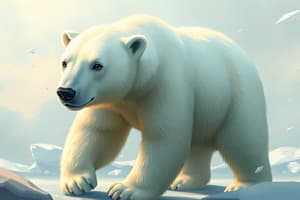Podcast
Questions and Answers
What are the two latitude lines that mark the Polar Circles?
What are the two latitude lines that mark the Polar Circles?
Arctic Circle and Antarctic Circle
What is the significance of the Polar Circles in terms of daylight and darkness?
What is the significance of the Polar Circles in terms of daylight and darkness?
They experience extremely long days during the summer season and extremely long nights during winter.
Describe the path of sunlight near the Equator compared to near the poles.
Describe the path of sunlight near the Equator compared to near the poles.
Near the Equator, sunlight falls almost perpendicularly, while near the poles it falls obliquely.
On what date does the region surrounded by the Antarctic Circle experience 24 hours of continuous sunlight?
On what date does the region surrounded by the Antarctic Circle experience 24 hours of continuous sunlight?
What effect does the oblique path of sunlight near the poles have on its intensity?
What effect does the oblique path of sunlight near the poles have on its intensity?
What significant influence does latitude have on the Earth's climate and weather?
What significant influence does latitude have on the Earth's climate and weather?
What are the important divisions based on latitude, and what are their distinct characteristics?
What are the important divisions based on latitude, and what are their distinct characteristics?
In which regions does the Tropic of Cancer and the Tropic of Capricorn demarcate, and what are the characteristics of these regions?
In which regions does the Tropic of Cancer and the Tropic of Capricorn demarcate, and what are the characteristics of these regions?
How does latitude influence the nature of land and living organisms in a particular place?
How does latitude influence the nature of land and living organisms in a particular place?
What is the significance of the axial tilt of the Earth at an angle of 23.5°?
What is the significance of the axial tilt of the Earth at an angle of 23.5°?
Flashcards are hidden until you start studying
Study Notes
Polar Circles
- The Arctic Circle is located at approximately 66.5°N latitude, while the Antarctic Circle is at approximately 66.5°S latitude.
- These circles signify regions where, during certain times of the year, there are periods of continuous daylight or darkness.
Daylight and Darkness
- Within the Polar Circles, there can be 24 hours of daylight in summer and 24 hours of darkness in winter, known as polar day and polar night.
- This phenomena occurs due to the tilt of the Earth's axis and its orbit around the Sun.
Sunlight Path
- Near the Equator, sunlight strikes the Earth directly, resulting in consistent and intense solar radiation throughout the year.
- Near the poles, sunlight arrives at a more oblique angle, causing spreading over a larger area and reducing intensity.
Continuous Sunlight in Antarctica
- The Antarctic Circle experiences 24 hours of continuous sunlight during the summer solstice around December 21st.
Intensity of Sunlight
- The oblique angle of sunlight at high latitudes means that rays cover a larger area, leading to lower intensity compared to areas closer to the equator.
Influence of Latitude on Climate
- Latitude significantly impacts climate and weather patterns; regions closer to the equator are typically warmer and experience tropical climates, while polar regions are colder.
- Variations in daylight duration and angle of sunlight affect temperature and precipitation levels in different latitudes.
Divisions Based on Latitude
- There are essential latitude divisions: Polar, Temperate, and Tropical.
- Polar regions are characterized by extreme cold and ice; Temperate regions have moderated climates with four distinct seasons; Tropical regions are hot and humid.
Tropic of Cancer and Tropic of Capricorn
- The Tropic of Cancer is located at 23.5°N, while the Tropic of Capricorn is at 23.5°S.
- These tropics delineate the areas where the sun can be directly overhead at noon during their respective solstices, leading to tropical climates with high biodiversity.
Latitude and Ecosystems
- Latitude affects the types of landforms, climate conditions, and biodiversity, influencing the distribution and adaptations of living organisms.
Axial Tilt of the Earth
- The Earth's axial tilt of 23.5° is crucial for creating seasons; it determines the intensity and distribution of sunlight, which affects weather and climate patterns globally.
Studying That Suits You
Use AI to generate personalized quizzes and flashcards to suit your learning preferences.




